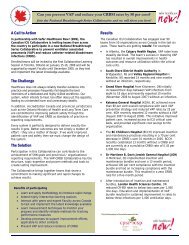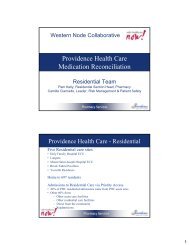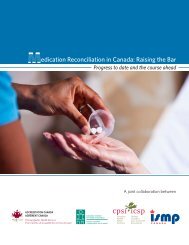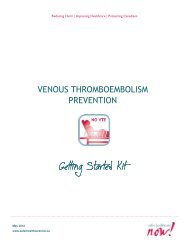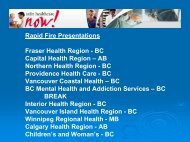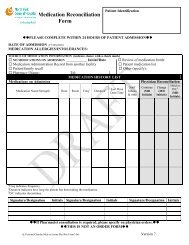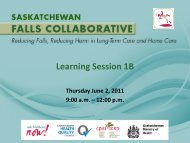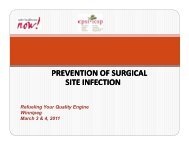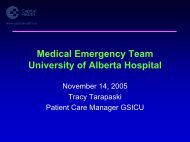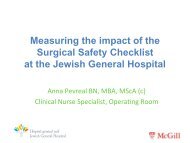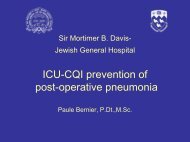VAP Getting Started Kit - Safer Healthcare Now!
VAP Getting Started Kit - Safer Healthcare Now!
VAP Getting Started Kit - Safer Healthcare Now!
You also want an ePaper? Increase the reach of your titles
YUMPU automatically turns print PDFs into web optimized ePapers that Google loves.
<strong>Safer</strong> <strong>Healthcare</strong> <strong>Now</strong>! Prevent Ventilator Associated Pneumonia <strong>Getting</strong> <strong>Started</strong> <strong>Kit</strong><br />
management with a daily SAT followed by an SBT (intervention group) or with sedation per usual<br />
care plus a daily SBT (control group). Patients in the intervention group spent more days<br />
breathing without assistance during the 28-day study period than did those in the control group<br />
(14.7 vs. 11.6 days; p=0.02) and were discharged from ICU (median time 9.1 days vs. 12.9 days;<br />
p=0.01) and the hospital earlier (median time 14.9 days vs. 19.2 days; p=0.04). Although more<br />
patients in the intervention group self-extubated than in the control group (p=0.03), the number<br />
of patients who required re-intubation after self-extubation was similar. Furthermore, during<br />
the year after enrolment, patients in the intervention group were less likely to die than were<br />
patients in the control group (Hazard Ratio 0.68; p=0.01) such that for every 7 patients treated<br />
with the intervention, one life was saved (number needed to treat was 7.4, 95% CI 4.2-35.5).<br />
The “wake up and breathe” flow sheets are readily available online. 75,76 Furthermore, in an a<br />
priori planned substudy conducted in one participating ICU during this trial, the authors found<br />
that the wake up and breathe protocol resulted in similar cognitive, psychological, and<br />
functional outcomes among patients tested 3 and 12 months post-ICU, ie the protocol benefits<br />
were not offset by adverse long-term outcomes. 77 It should be noted that the protocol was<br />
devised so that an SAT required holding even narcotics unless they were specifically prescribed<br />
for analgesia, underlining the importance of documenting the goals for medication use in these<br />
patients.<br />
What changes can we make that will result in improvement?<br />
Hospital teams across Canada and the United States have developed and tested process and<br />
system changes that allowed them to improve performance on daily sedation interruption<br />
and daily assessment of readiness to extubate. These measures, taken together, support the<br />
implementation of the <strong>VAP</strong> Bundle.<br />
Some of these changes are:<br />
• Implement a process to temporarily interrupt sedation (spontaneous awakening trial or<br />
SAT) daily at an appropriate time (e.g., before multidisciplinary rounds but after AM<br />
nursing change of shift) to reappraise the patients’ neurocognitive ability to assume a<br />
viable breathing pattern and his/her needs for sedation/analgesia. All patients receiving<br />
sedation administered either as continuous IV infusion or as PRN should be candidates for<br />
SAT.<br />
• Consider a SAT Safety Screen, with specific allowable contraindications (e.g. Patient<br />
receiving sedative infusion for active seizures or alcohol withdrawal, or escalating doses<br />
due to ongoing agitation, or the presence of neuromuscular blocking agents, has<br />
experienced myocardial ischemia within 24 hours or currently has increased intracranial<br />
pressure).<br />
• Spontaneous Awakening Trial (SAT). After having stopped all sedatives and analgesics<br />
used for sedation (continue analgesics for active pain), patient passes SAT if: opens eyes<br />
to verbal stimuli or tolerates sedation interruption for >4 hours. Patient fails if<br />
experiences: sustained anxiety, agitation, or pain, or has respiratory rate > 35 or Sp02 <<br />
88% for 5 or more minutes, or 2 or more signs of respiratory distress, or acute<br />
dysrhythmia. If SAT failed, medications are restarted at half dose and titrated.<br />
June 2012 18



